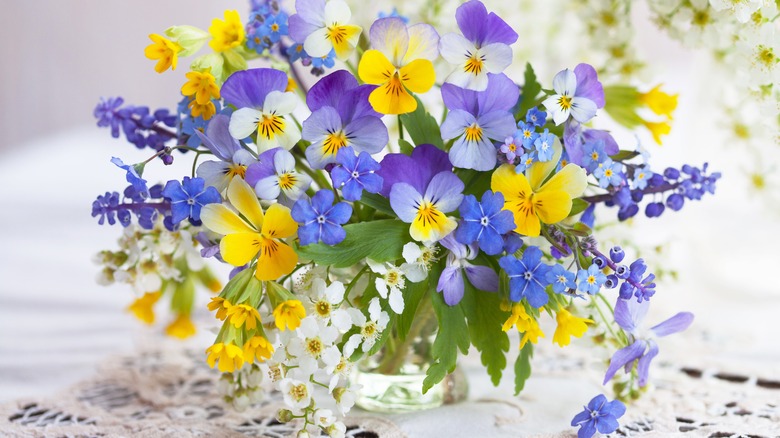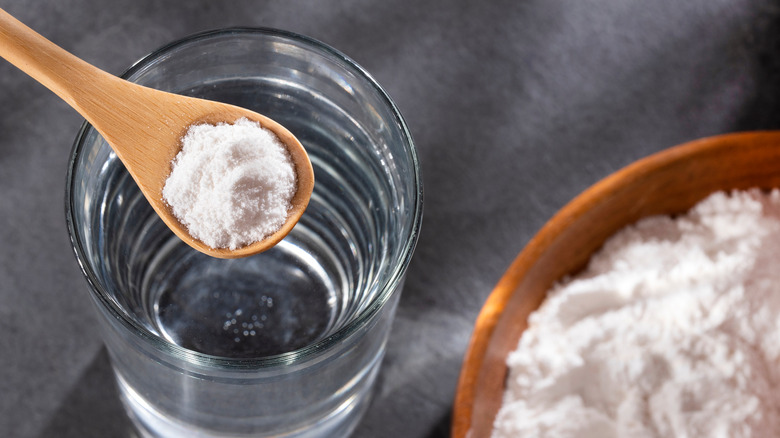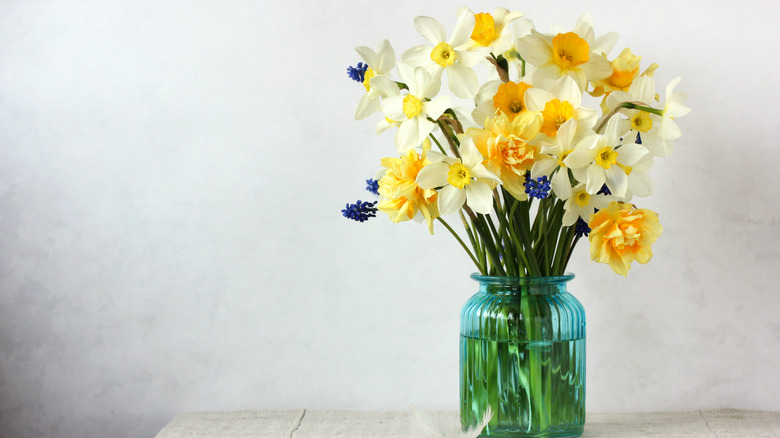Revive Your Home's Beautiful Flower Displays With Just Baking Soda And Water
Is there anything more uplifting than having a vase of beautiful, fresh flowers in the house? Whether they're used for a dining room centerpiece or a colorful bit of natural decor, fresh flowers perk up a room like nothing else. So it can be pretty sad when those flowers start to droop a bit. Some people swear by just using a bit of sugar in the water to cheer up your blossoms, but sugar can actually feed bacteria, and bacteria is one of the main culprits causing flowers to wilt in the vase, according to bloomon.
Some flower shops provide a small packet of "flower food" (such as FloraLife) with a cut bouquet, to mix into the water and help preserve the flowers' freshness. These packets normally contain a mixture of sugar, citric acid (a preservative), and bleach (to deter bacteria) — but, according to the Koch & Co. Blog, it is possible to use too much of this food and cause discoloration. Changing the vase water frequently also helps maintain freshness, but there's another very easy trick to prolong the life of flowers in a display. It involves a common household item most people already have in their pantry: baking soda.
How does baking soda work to keep flowers fresh?
Baking soda is a simple ingredient with numerous surprisingly useful applications in the household for cleaning and other tasks — and it turns out that it also helps keep flowers fresh and perky in the vase. The reason baking soda works for this purpose is twofold. First, it doesn't provide a food source for bacteria to grow the way sugar does. Second, baking soda helps create a neutral balance in the water between acidic and alkaline, which prolongs the life of the cut flower, according to Bloomingbox. They recommend adding a teaspoon of baking soda to the vase water and mixing thoroughly, and repeating this trick when changing the water — which should only be done if it starts looking murky.
For a healthy arrangement and clearer water that doesn't need to be changed as often, first things first: Make sure your vases are clean before filling them with water, as any residue might carry bacteria that will shorten the life of your bouquet. In fact, cleaning foggy vases is another project you can use baking soda for! Barton Hill Farms also recommends not having any leaves below the water line (where they might get slimy and provide another haven for bacteria), so trim the lower parts of the flower stems well before placing them in their container.
Daffodils in your display are a bit of an exception
There are beautiful flowers for all seasons, but when spring arrives, their beauty and fragrance are so thrilling that many people want to bring a display of seasonal blooms inside as soon as possible. A bouquet of tulips, daffodils, and hyacinths just radiates vitality, and the baking soda trick will work great on those cut spring flowers whether they come from a personal garden or a florist — but daffodils do require a bit of extra attention if you want reliable results.
The Old Farmer's Almanac warns that daffodil stems contain a thick mucilaginous sap, which is obvious to anyone who has ever picked them. This sap can be a skin irritant (in fact, daffodils contain several toxic substances and should be handled with care, according to SFGate). When it flows into the water used in a flower vase, it can poison other types of flowers — and baking soda won't keep that from happening.
Instead, there are two ways to avoid this: First, try placing your cut daffodils in water by themselves for a while before adding them to your regular arrangement. This can help a mixed bouquet stay fresher for longer. Second, consider keeping your daffodils in a separate vase altogether so they don't undermine the benefits of your baking soda trick. After all, the Brooklyn Botanic Garden cautions that "daffodils should not be mixed with other flowers if you want a long-lasting arrangement." If you go this route, change the water frequently to keep the daffodils fresh and dilute seepage, enjoying their beauty away from other blooms — and minimizing water turnover in your bouquet that could interfere with baking soda's fortifying effect.


